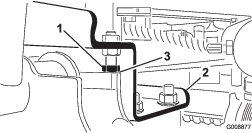| Maintenance Service Interval | Maintenance Procedure |
|---|---|
| Before each use or daily |
|
Introduction
This machine is a ride-on, rotary-blade lawnmower intended to be used by professional, hired operators in commercial applications. It is primarily designed for cutting grass on well-maintained lawns in parks, golf courses, sports fields, and on commercial grounds. It is not designed for cutting brush, mowing grass and other growth alongside highways, or for agricultural uses.
Read this information carefully to learn how to operate and maintain your product properly and to avoid injury and product damage. You are responsible for operating the product properly and safely.
You may contact Toro directly at www.Toro.com for product and accessory information, help finding a dealer, or to register your product.
Whenever you need service, genuine Toro parts, or additional information, contact an Authorized Service Dealer or Toro Customer Service and have the model and serial numbers of your product ready. Figure 1identifies the location of the model and serial numbers on the product. Write the numbers in the space provided.
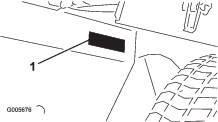
This manual identifies potential hazards and has safety messages identified by the safety alert symbol (Figure 2), which signals a hazard that may cause serious injury or death if you do not follow the recommended precautions.

This manual uses 2 other words to highlight information. Important calls attention to special mechanical information and Note emphasizes general information worthy of special attention.
This product complies with all relevant European directives; for details please see the separate product specific Declaration of Conformity (DOC) sheet.
It is a violation of California Public Resource Code Section 4442 or 4443 to use or operate the engine on any forest-covered, brush-covered, or grass-covered land unless the engine is equipped with a spark arrester, as defined in Section 4442, maintained in effective working order or the engine is constructed, equipped, and maintained for the prevention of fire.
The enclosed engine owner's manual is supplied for information regarding the US Environmental Protection Agency (EPA) and the California Emission Control Regulation of emission systems, maintenance, and warranty. Replacements may be ordered through the engine manufacturer.
Warning
CALIFORNIA
Proposition 65 Warning
Diesel engine exhaust and some of its constituents are known to the State of California to cause cancer, birth defects, and other reproductive harm.
Battery posts, terminals, and related accessories contain lead and lead compounds, chemicals known to the State of California to cause cancer and reproductive harm. Wash hands after handling.
Use of this product may cause exposure to chemicals known to the State of California to cause cancer, birth defects, or other reproductive harm.
Safety
This machine has been designed in accordance with EN ISO 5395:2013 and ANSI B71.4-2012 specifications in effect at the time of production when equipped with required weight as listed in Rear Ballast section.
Improper use or maintenance by the operator or owner can result in injury. To reduce the potential for injury, comply with these safety instructions and always pay attention to the safety alert symbol, which means Caution, Warning, or Danger—personal safety instruction. Failure to comply with the instruction may result in personal injury or death.
Safe Operating Practices
Training
-
Read the Operator’s Manual and other training material carefully. Be familiar with the controls, safety signs, and the proper use of the equipment.
-
If the operator or mechanic can not read the language of this manual, it is the owner’s responsibility to explain this material to them.
-
Never allow children or people unfamiliar with these instructions to use or service the mower. Local regulations may restrict the age of the operator.
-
Never mow while people, especially children, or pets are nearby.
-
Keep in mind that the operator or user is responsible for accidents or hazards occurring to other people or their property.
-
Do not carry passengers.
-
All drivers and mechanics should seek and obtain professional and practical instruction. The owner is responsible for training the users. Such instruction should emphasize the following:
-
The need for care and concentration when working with ride-on machines
-
Control of a ride-on machine sliding on a slope will not be regained by the application of the brake. The main reasons for loss of control are as follows:
-
Insufficient wheel grip
-
Being driven too fast
-
Inadequate braking
-
The type of machine is unsuitable for the task
-
Lack of awareness of the effect of ground conditions, especially slopes
-
Incorrect hitching and load distribution
-
-
Preparation
-
While mowing, always wear substantial footwear, long trousers, hard hat, safety glasses, and hearing protection. Long hair, loose clothing, or jewelry may get tangled in moving parts. Do not operate the equipment when barefoot or wearing open sandals.
-
Thoroughly inspect the area where the equipment is to be used and remove all objects which may be thrown by the machine.
-
Replace faulty silencers/mufflers.
-
Before using, always visually inspect to see that the blades, blade bolts, and cutting assembly are not worn or damaged. Replace worn or damaged blades and bolts in sets to preserve balance.
-
On multi-bladed machines, take care as rotating one blade can cause other blades to rotate.
-
Evaluate the terrain to determine what accessories and attachments are needed to properly and safely perform the job. Only use accessories and attachments approved by the manufacturer.
-
Check that operator’s presence controls, safety switches and shields are attached and functioning properly. Do not operate unless they are functioning properly.
Safe Handling of Fuels
-
To avoid personal injury or property damage, use extreme care in handling gasoline. Gasoline is extremely flammable and the vapors are explosive.
-
Extinguish all cigarettes, cigars, pipes, and other sources of ignition.
-
Use only an approved fuel container.
-
Never remove fuel cap or add fuel with the engine running.
-
Allow engine to cool before refueling.
-
Never refuel the machine indoors.
-
Never store the machine or fuel container where there is an open flame, spark, or pilot light such as on a water heater or on other appliances.
-
Never fill containers inside a vehicle or on a truck or trailer bed with a plastic liner. Always place containers on the ground away from your vehicle before filling.
-
Remove equipment from the truck or trailer and refuel it on the ground. If this is not possible, then refuel such equipment with a portable container, rather than from a fuel dispenser nozzle.
-
Keep the nozzle in contact with the rim of the fuel tank or container opening at all times until fueling is complete. Do not use a nozzle lock open device.
-
If fuel is spilled on clothing, change clothing immediately.
-
Never overfill fuel tank. Replace fuel cap and tighten securely.
Operation
-
Do not operate the engine in a confined space where dangerous carbon monoxide fumes can collect.
-
Mow only in daylight or in good artificial light.
-
Before attempting to start the engine, disengage all blade attachment clutches, shift into neutral, and engage the parking brake. Only start the engine from the operator’s position. Never remove the ROPS and always wear the seat belts during operation.
-
Do not put hands or feet near or under rotating parts. Keep clear of the discharge opening at all times.
-
Remember there is no such thing as a safe slope. Travel on grass slopes requires particular care. Do the following to guard against overturning:
-
Do not stop or start suddenly when going up or downhill.
-
Keep machine speeds low on slopes and during tight turns.
-
Stay alert for humps and hollows and other hidden hazards.
-
Never mow across the face of the slope, unless the mower is designed for this purpose.
-
-
Stay alert for holes in the terrain and other hidden hazards.
-
Watch out for traffic when crossing or near roadways.
-
Stop the blades from rotating before crossing surfaces other than grass.
-
When using any attachments, never direct discharge of material toward bystanders nor allow anyone near the machine while in operation.
-
Never operate the machine with damaged guards, shields, or without safety protective devices in place. Be sure all interlocks are attached, adjusted properly, and functioning properly.
-
Do not change the engine governor settings or overspeed the engine. Operating the engine at excessive speed may increase the hazard of personal injury.
-
Do the following before leaving the operator’s position:
-
Stop on level ground.
-
Disengage the power take-off and lower the attachments.
-
Change into neutral and set the parking brake.
-
Stop the engine and remove the key.
-
-
Disengage the drive to attachments, stop the engine, and remove the ignition key in the following conditions:
-
Before making height adjustments, unless the adjustment can be made from the operator’s position.
-
Before clearing blockages
-
Before checking, cleaning, or working on the mower
-
After striking a foreign object or if an abnormal vibration occurs (check immediately). Inspect the mower for damage and make repairs before restarting and operating the equipment. Torque all the spindle pulley nuts to 176 to 203 N-m (130 to 150 ft-lb).
-
-
Disengage the drive to attachments when transporting or when not machine is not in use.
-
Stop the engine and disengage the drive to attachments before the following:
-
Refueling
-
Making height adjustment, unless the adjustment can be made from the operator's position
-
-
Reduce the throttle setting before stopping the engine and, if the engine is provided with a fuel shut-off valve, turn the fuel off at the conclusion of mowing.
-
Never raise the cutting unit with the blades running.
-
Keep hands and feet away from the cutting units.
-
Look behind and down before backing up to be sure of a clear path.
-
Slow down and use caution when making turns and crossing roads and sidewalks.
-
Do not operate the mower under the influence of alcohol or drugs.
-
Lightning can cause severe injury or death. If lightning is seen or thunder is heard in the area, do not operate the machine; seek shelter.
-
Use care when loading or unloading the machine into a trailer or truck.
-
The operator shall turn on flashing warning lights, if provided, whenever traveling on a public road, except where such use is prohibited by law.
Maintenance and Storage
-
Keep all nuts, bolts and screws tight to be sure the equipment is in safe working condition.
-
Never store the equipment with fuel in the tank inside a building where fumes may reach an open flame or spark.
-
Allow the engine to cool before storing in any enclosure.
-
To reduce the fire hazard, keep the engine, silencer/muffler, battery compartment fuel storage area, cutting units and drives free of grass, leaves, or excessive grease. Clean up oil or fuel spillage.
-
Replace worn or damaged parts for safety.
-
If the fuel tank has to be drained, do this outdoors.
-
On multi-bladed machines, take care as rotating one blade can cause other blades to rotate.
-
When machine is to be parked, stored, or left unattended, lower the cutting units unless a positive mechanical lock is provided.
-
Disengage drives, lower the cutting units, set parking brake, stop engine and remove key. Wait for all movement to stop before adjusting, cleaning or repairing.
-
Shut off fuel while storing or transporting. Do not store fuel near flames.
-
Park the machine on level ground. Never allow untrained personnel to service machine.
-
Use jack stands to support components when required.
-
Carefully release pressure from components with stored energy.
-
Disconnect battery before making any repairs. Disconnect the negative terminal first and the positive last. Reconnect positive first and negative last.
-
Use care when checking the blades. Wrap the blades or wear gloves, and use caution when servicing them. Only replace blades. Never straighten or weld them.
-
Keep hands and feet away from moving parts. If possible, do not make adjustments with the engine running.
-
Charge batteries in an open well ventilated area, away from spark and flames. Unplug charger before connecting or disconnecting from battery. Wear protective clothing and use insulated tools.
Hauling
-
Use care when loading or unloading the machine into a trailer or truck.
-
Use full width ramps for loading machine into trailer or truck.
-
Tie the machine down securely using straps, chains, cable, or ropes. Both front and rear straps should be directed down and outward from the machine
Toro Mower Safety
The following list contains safety information specific to Toro products or other safety information that you must know that is not included in the CEN, ISO, or ANSI standards.
This product is capable of amputating hands and feet and throwing objects. Always follow all safety instructions to avoid serious injury or death.
Use of this product for purposes other than its intended use could prove dangerous to user and bystanders.
Warning
Engine exhaust contains carbon monoxide, which is an odorless, deadly poison that can kill you. Do not run engine indoors or in an enclosed area.
Preparation
Be sure to establish your own special procedures and work rules for unusual operating conditions (e.g., slopes too steep for operation). Survey the complete mowing site to determine which hills can be safely operated on. When performing this site survey, always use common sense and take into consideration the turf condition and the rollover risk. To determine which hills or slopes may be safely operated on, use the inclinometer provided with each machine. To perform a site survey, follow the procedure outlined in the Operation section of the this manual. The maximum side hill angle is detailed on the slope decal affixed near the angle indicator.
Training
The operator must be skilled and trained in how to drive on hillsides. Failure to use caution on slopes or hills may cause the vehicle to tip or roll, possibly resulting in personal injury or death.
Operation
-
Know how to stop the machine and engine quickly.
-
Do not operate the machine while wearing tennis shoes or sneakers.
-
Wearing safety shoes and long pants is advisable and required by some local ordinances and insurance regulations.
-
Keep hands, feet, and clothing away from moving parts and the mower discharge area.
-
Fill the fuel tank until level is 12 mm (1/2 inch) below the bottom of the filler neck. Do not overfill.
-
Check the safety interlock switches daily for proper operation. If a switch should fail, replace the switch before operating the machine.
-
When starting the engine, engage the parking brake, put the traction pedal in neutral, and disengage the blade drive. After the engine starts, release the parking brake and keep your foot off of the traction pedal. The machine must not move. If movement is evident, refer to the Maintenance section of this manual to adjust the traction drive.
-
Use extreme caution when operating close to sand traps, ditches, creeks, steep hillsides, or other hazards.
-
Reduce speed when making sharp turns.
-
Do not turn on hills.
-
Do not operate on a side hill that is too steep. A rollover may occur before losing traction.
-
On models 30839, 30843 and 30807, the slope angle at which the machines will tip is dependent on many factors. Among these are mowing conditions such as wet or undulating terrain, speed (especially in turns), position of the cutting units (with the Sidewinder), tire pressure, and operator experience. At side hill angles of 20 degrees or less, the risk of a rollover is low. As the slope angle increases to a recommended maximum limit of 25 degrees, the risk of a rollover increases to a moderate level. Do not exceed a 25 degree side hill slope angle because the risk of a rollover and serious injury or death is very high.
-
On model 30849, the slope angle at which the machine will tip is dependent on many factors. Among these are mowing conditions such as wet or undulating terrain, speed (especially in turns), position of the cutting units (with the Sidewinder), tire pressure, and operator experience. At side hill angles of 15 degrees or less, the risk of a rollover is low. As the slope angle increases to a recommended maximum limit of 20 degrees, the risk of a rollover increases to a moderate level. Do not exceed a 20 degree side hill slope angle because the risk of a rollover and serious injury or death is very high.
-
For steering control, lower the cutting units when going down slopes.
-
Avoid sudden stops and starts.
-
Use the reverse pedal for braking.
-
Watch for traffic when near or crossing roads. Always yield the right-of-way.
-
Raise the cutting units when driving from one work area to another.
-
Do not touch the engine, muffler, exhaust pipe, or hydraulic tank while the engine is running or soon after it has stopped because these areas could be hot enough to cause burns.
-
This machine is not designed or equipped for on-road use and is a slow-moving vehicle. If you must cross or travel on a public road, you should be aware of and comply with local regulations, such as required lights, slow moving vehicle signs, and reflectors.
Maintenance and Storage
-
Before servicing or making adjustments, stop the engine and remove the ignition key.
-
Ensure that the entire machine is properly maintained and in good operating condition. Frequently check all nuts, bolts, screws, and hydraulic fittings.
-
Make sure all hydraulic line connectors are tight and all hydraulic hoses and lines are in good condition before applying pressure to the system.
-
Keep your body and hands away from pin hole leaks or nozzles that eject hydraulic fluid under high pressure. Use paper or cardboard, not your hands, to search for leaks. Hydraulic fluid escaping under pressure can have sufficient force to penetrate the skin and cause serious injury. If fluid is injected into the skin it must be surgically removed within a few hours by a doctor familiar with this form of injury or gangrene may result.
-
Before disconnecting or performing any work on the hydraulic system, all pressure in the system must be relieved by stopping the engine and lowering the cutting units to the ground.
-
If the engine must be running to perform a maintenance adjustment, keep hands, feet, clothing, and any parts of the body away from the cutting units, attachments, and any moving parts. Keep everyone away.
-
Do not overspeed the engine by changing governor settings. To ensure safety and accuracy, have an Authorized Toro Distributor check the maximum engine speed with a tachometer.
-
The engine must be shut off before checking the oil or adding oil to the crankcase.
-
If major repairs are ever needed or if assistance is desired, contact an Authorized Toro Distributor.
-
To ensure optimum performance and continued safety certification of the machine, use only genuine Toro replacement parts and accessories. Replacement parts and accessories made by other manufacturers could be dangerous, and such use could void the product warranty.
Sound Power Level
This unit has a guaranteed sound power level of 104 dBA, which includes an Uncertainty Value (K) of 1 dBA.
Sound power level was determined according to the procedures outlined in ISO 11094.
Sound Pressure Level
This unit has a sound pressure level at the operator’s ear of 90 dBA, which includes an Uncertainty Value (K) of 1 dBA.
Sound pressure level was determined according to the procedures outlined in EN ISO 5395:2013.
Vibration Level
Hand-Arm
Measured vibration level for right hand = 0.5 m/s2
Measured vibration level for left hand = 0.7 m/s2
Uncertainty Value (K) = 0.5 m/s2
Measured values were determined according to the procedures outlined in EN ISO 5395:2013.
Whole Body
Measured vibration level = 0.44 m/s2
Uncertainty Value (K) = 0.5 m/s2
Measured values were determined according to the procedures outlined in EN ISO 5395:2013.
Safety and Instructional Decals
 |
Safety decals and instructions are easily visible to the operator and are located near any area of potential danger. Replace any decal that is damaged or lost. |







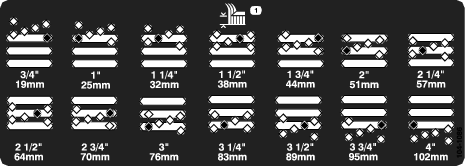
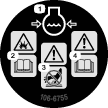

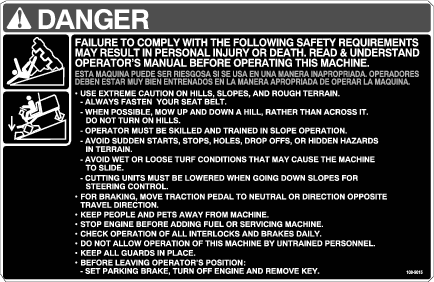
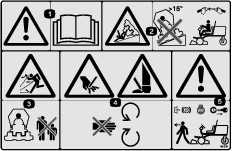



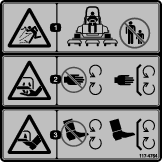
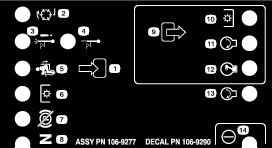
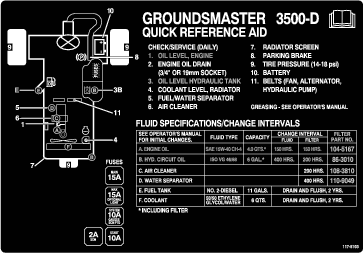
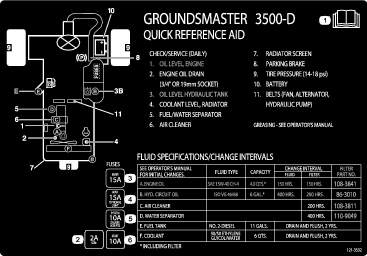
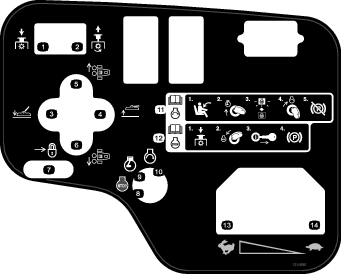
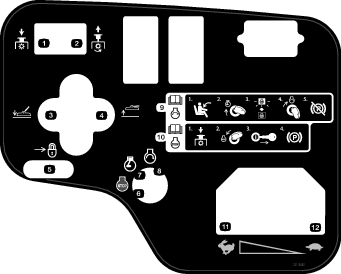
Setup
Note: Determine the left and right sides of the machine from the normal operating position.
Activating, Charging, and Connecting the Battery
Warning
Battery posts, terminals, and related accessories contain lead and lead compounds, chemicals known to the State of California to cause cancer and reproductive harm. Wash hands after handling.
Note: If the battery is not filled with electrolyte or activated, bulk electrolyte with 1.260 specific gravity must be purchased from a local battery supply outlet and added to the battery.
Danger
Battery electrolyte contains sulfuric acid which is a deadly poison and causes severe burns.
-
Do not drink electrolyte and avoid contact with skin, eyes, or clothing. Wear safety glasses to shield your eyes and rubber gloves to protect your hands.
-
Fill the battery where clean water is always available for flushing the skin.
-
Remove the battery cover (Figure 3).
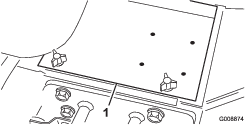
-
Remove the filler caps from the battery and slowly fill each cell until electrolyte is just above the plates.
-
Install the filler caps and connect a 3 to 4 amp battery charger to the battery posts.
Note: Charge the battery at a rate of 3 to 4 amperes for 4 to 8 hours.
Warning
Charging the battery produces gasses that can explode.
-
Keep sparks and flames away from battery.
-
Never smoke near the battery.
-
-
When the battery is charged, disconnect the charger from the electrical outlet and battery posts.
-
Remove the filler caps.
-
Slowly add electrolyte to each cell until the level is up to the fill ring.
Important: Do not overfill the battery. Electrolyte will overflow onto other parts of the machine and severe corrosion and deterioration will result.
-
Install the filler caps.
-
Install the positive cable (red) to the positive (+) terminal and the negative cable (black) to the negative (–) terminal of the battery and secure them with bolts and nuts (Figure 4).
Note: Make sure that the positive (+) terminal is all of the way onto the post and the cable is positioned snug to the battery. The cable must not contact the battery cover.
Warning
Incorrect battery cable routing could damage the tractor and cables causing sparks. Sparks can cause the battery gasses to explode, resulting in personal injury.
-
Always disconnect the negative (black) battery cable before disconnecting the positive (red) cable.
-
Always connect the positive (red) battery cable before connecting the negative (black) cable.
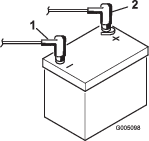
Important: If the battery is ever removed, make sure that the battery clamp bolts are installed with the bolt heads positioned on the bottom side and the nuts on the top side. If the clamp bolts are reversed, they may interfere with the hydraulic tubes when shifting the cutting units.
-
-
Coat both battery connections with Grafo 112X (skin over) grease, Toro Part No. 505-47, petroleum jelly, or light grease to prevent corrosion.
-
Slide the rubber boot over the positive terminal to prevent a possible short from occurring.
-
Install the battery cover.
Checking the Angle Indicator
Parts needed for this procedure:
| Inclinometer | 1 |
Danger
To reduce risk of injury or death due to rollover, do not operate the machine on side hills steeper than 25º.
-
Park the machine on a flat, level surface.
-
Verify that the machine is level by placing a hand held inclinometer (supplied with the machine) on the frame cross rail, by the fuel tank (Figure 5).
Note: The inclinometer should read zero degrees when viewed from the operator’s position.

-
If the inclinometer does not read zero degrees, move the machine to a location where a zero degree reading is obtained.
Note: The angle indicator, mounted on the machine, should now read zero degrees as well.
-
If the angle indicator does not read zero degrees, loosen the two screws and nuts securing the angle indicator to the mounting bracket, adjust the indicator to obtain a zero degree reading, and tighten the bolts.
Installing the CE Decals
Parts needed for this procedure:
| Warning decal (104–5181) | 1 |
| Warning decal (99–3558) | 1 |
| Warning decal (107–1972) | 3 |
If this machine will be used for CE, affix the CE warning decals over the corresponding English warning decals.
Installing the Hood Latch (CE Only)
Parts needed for this procedure:
| Lock bracket | 1 |
| Rivet | 2 |
| Washer | 1 |
| Screw, 1/4 x 2 inches | 1 |
| Locknut, 1/4 inch | 1 |
-
Unhook the hood latch from the hood latch bracket.
-
Remove the (2) rivets securing the hood latch bracket to the hood (Figure 6).
Note: Remove the hood latch bracket from the hood.
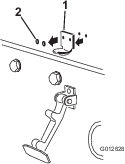
-
While aligning the mounting holes, position the CE lock bracket and the hood latch bracket onto the hood. The lock bracket must be against the hood (Figure 7).
Note: Do not remove bolt and nut assembly from the lock bracket arm.
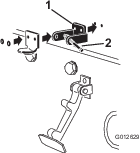
-
Align the washers with the holes on the inside of the hood.
-
Rivet the brackets and the washers to the hood (Figure 7).
-
Hook the latch onto the hood latch bracket (Figure 8).
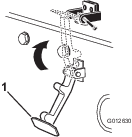
-
Screw the bolt into the other arm of hood lock bracket to lock the latch in position (Figure 9).
Note: Tighten bolt securely but do not tighten nut.
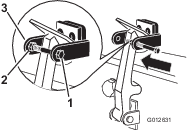
Installing the Exhaust Guard (CE Only)
Adjusting the Lift Arms
-
Start the engine, raise the cutting units, and check to ensure that the clearance between each lift arm and the floor plate bracket is 5 to 8 mm (0.18 to 0.32 inches) (Figure 11).
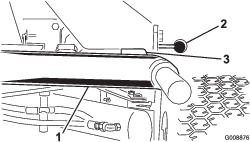
If the clearance is not in this range, adjust it as follows:
-
Check to make sure that the clearance between each lift arm and stop bolt is 0.13 to 1.02 mm (0.005 to 0.040 inches) (Figure 12). If the clearance is not in this range, adjust the stop bolts to attain clearance.
-
Start the engine, raise the cutting units, and check to make sure that the clearance between the wear strap on the top of the rear cutting unit wear bar and the bumper strap is 0.51 to 2.54 mm (0.02 to 0.10 inches) (Figure 14).

If the clearance is not in this range, adjust the rear cylinder as follows:
Note: If the rear lift arm clunks during transport, clearance can be reduced.
-
Lower the cutting units and back off the jam nut on the cylinder (Figure 15).
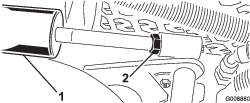
-
Grasp the cylinder rod close to the nut with a pliers and rag and rotate the rod.
-
Raise the cutting units and check the clearance. Repeat the procedure if required.
-
Tighten the clevis jam nut.
-
Important: Lack of clearance at the front stops or rear wear bar could damage the lift arms.
Adjusting the Carrier Frame
Adjusting the Front Cutting Decks
The front and rear cutting decks require different mounting positions. The front cutting deck has two mounting positions depending on what height-of-cut and degree of deck rotation you desire.
-
For heights of cut in the 2 to 7.6 cm (3/4 to 3 inch) range, mount the front carrier frames in the lower front mounting holes (Figure 16).
Note: This permits more up travel of the cutting decks relative to tractor when approaching quick uphill changes in terrain. It does however limit the clearance of the chamber to the carrier when cresting sharp knolls.
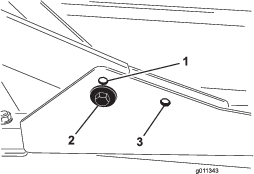
-
For heights of cut in the 6.3 to 10 cm (2-1/2 to 4 inch) range, mount the front carrier frames in the upper front mounting holes (Figure 16).
Note: This increases the chamber to carrier clearance due to the higher position of the cutting chamber, but will cause the cutting deck to reach their maximum up travel sooner.
Adjusting the Rear Cutting Deck
The front and rear cutting decks require different mounting positions. The rear cutting deck has one mounting position for proper alignment with the sidewinder under frame.
For all heights of cut, mount the rear cutting deck in the rear mounting holes (Figure 16).
Adjusting the Height-of-Cut
Important: This cutting deck often cuts approximately 6 mm (1/4 inch) lower than a reel cutting unit with the same bench setting. It may be necessary to have these rotary cutting deck’s bench set 6 mm (1/4 inch) above that of reels cutting in the same area.
Important: Access to the rear cutting units is greatly improved by removing the cutting unit from the tractor. If the unit is equipped with a Sidewinder®, sidewind the cutting units to the right, remove the rear cutting unit, and slide it out to the right side.
-
Lower the cutting deck to the ground, stop the engine, and remove the key from ignition switch.
-
Loosen the bolt securing each height-of-cut bracket to the height-of-cut plate (front and each side) (Figure 17).
-
Beginning with front adjustment, remove the bolt.
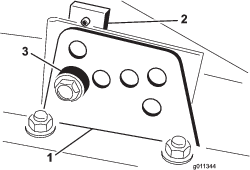
-
While supporting the chamber, remove the spacer (Figure 17).
-
Move the chamber to the desired height-of-cut and install a spacer into the designated height-of-cut hole and slot (Figure 18).

-
Position the tapped plate in line with the spacer.
-
Install the bolt finger tight.
-
Repeat steps 4-7 for each side adjustment.
-
Tighten all three bolts to 41 N-m (30 ft-lb). Always tighten the front bolt first.
Note: Adjustments of more than 3.8 cm (1-1/2 inches) may require temporary assembly to an intermediate height to prevent binding (e.g. changing from 3.1 to 7 cm (1.25 to 2.75 inch) height-of-cut).
Adjusting the Roller Scraper (Optional)
The optional rear roller scraper is designed to work best when there is an even gap of 0.5 to 1 mm (0.020–0.040 inch) between the scraper and roller.
-
Loosen the grease fitting and the mounting screw (Figure 19).

-
Slide the scraper up or down until a gap of 0.5 to 1 mm (0.020 to 0.040 inch) is achieved between the rod and the roller.
-
Secure the grease fitting and screw to 41 N-m (30 ft-lb) in an alternating sequence.
Installing the Mulching Baffle (Optional)
-
Thoroughly clean debris from the mounting holes on the rear wall and left side wall of the chamber.
-
Install the mulching baffle in the rear opening and secure it with 5 flange head bolts (Figure 20).
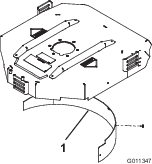
-
Verify that mulching baffle does not interfere with the tip of the blade and does not protrude inside the surface of the rear chamber wall.
Warning
Do not use the high lift blade with the mulching baffle. The blade could break, resulting in personal injury or death.
Product Overview
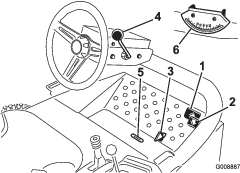
Traction Pedals
Mow/Transport Slide
Using your heel, move the mow/transport slide (Figure 21) to the left to transport and to the right to mow. The cutting units will only operate in the mow position.
Important: The mow speed is set at the factory to 9.7 km/h (6 MPH). It can be increased or decreased by adjusting the speed stop screw (Figure 22).

Tilt Steering Lever
Pull the tilt steering lever (Figure 21) back to tilt the steering wheel to the desired position. Then push the lever forward to tighten.
Indicator Slot
Models 30839, 30849 & 30807 only
The slot in the operator platform (Figure 21) indicates when the cutting units are in the center position.
Angle Indicator
Models 30839, 30843 & 30807 only
The angle indicator (Figure 21) indicates the side hill angle of the machine in degrees.
Ignition Switch
The ignition switch (Figure 23), used to start, stop, and preheat the engine, has three positions: Off, On/Preheat, and Start. Rotate the key to the On/Preheat position until the glow plug indicator light goes out (approximately 7 seconds); then rotate the key to the Start position to engage the starter motor. Release the key when the engine starts. The key will move automatically to the On/Run position. To shut the engine off, rotate the key to the Off position. Remove the key from the switch to prevent accidental starting.
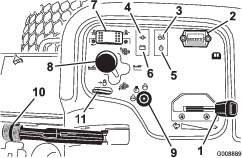
Throttle
Move the throttle (Figure 23) forward to increase the engine speed and rearward to decrease the engine speed.
Cutting Unit Drive Switch
The cutting unit drive switch (Figure 23) has two positions: Engage and Disengage. The rocker switch operates a solenoid valve on the valve bank to drive the cutting units.
Hour Meter
The hour meter (Figure 23) indicates the total hours of machine operation. The hour meter starts to function whenever the key switch is On.
Cutting Unit Shift Lever
To lower the cutting units to the ground, move the cutting unit shift lever (Figure 23) forward. The cutting units will not drop unless the engine is running. To raise the cutting units, pull the shift lever rearward to the Raise position.
On Models 30839, 30849 & 30807, move the lever to the right or left to move the cutting units in the same direction. This should only be done when the cutting units are raised or if they are on the ground and the machine is moving.
Note: The lever does not have to be held in the forward position while the cutting units are lowered.
Danger
On Models 30839, 30849 & 30807, shifting the cutting units downhill decreases machine stability. This could cause a rollover, which may result in personal injury or death.
Shift the cutting units uphill while on a side hill.
Engine Coolant Temperature Warning Light
The temperature warning light (Figure 23) glows if the engine coolant temperature is high. If the traction unit is not stopped and the coolant temperature rises another 10° F, the engine will kill.
Oil Pressure Warning Light
The oil pressure warning light (Figure 23) glows if the engine oil pressure drops below a safe level.
Alternator Light
The alternator light (Figure 23) should be off when the engine is running. If it is on, the charging system should be checked and repaired as necessary.
Glow Plug Indicator
The glow plug indicator light (Figure 23) will glow when the glow plugs are operating.
Parking Brake
Whenever the engine is shut off, engage the parking brake (Figure 23) to prevent accidental movement of the machine. To engage the parking brake, pull up on the lever. The engine will stop if you press the traction pedal with the parking brake engaged.
Lift Lever Lock
Move the lift lever lock (Figure 23) rearward to prevent the cutting units from dropping.
Fuel Gauge
The fuel gauge (Figure 24) registers the amount of fuel in the tank.
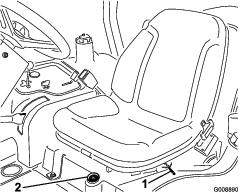
Fore and Aft Seat Adjustments
Move the lever (Figure 24) on the side of the seat outward, slide the seat to the desired position, and release the lever to lock the seat into position.
Note: Specifications and design are subject to change without notice.
| Traction Unit | |
|---|---|
| Overall Width - 68 inch width of cut | 182 cm (71.8 inches) |
| Overall Width - 72 inch width of cut | 193 cm (75.8 inches) |
| Length | 295 cm (116 inches) |
| Height to top of ROPS | 180 cm (70.8 inches) |
| Wheel Base | 149 cm) (58.5 inches) |
| Track Width | 145 cm (57 inches) |
| Ground Clearance | 15.3 cm (6 inches) |
| Weight with cutting unitsModels 30839, 30843 and 30807Model 30849 | 963 kg (2,124 lb)952 kg (2,099 lb) |
| Cutting Deck | |
| Length | 86.4 cm (34 inches) |
| Width | 86.4 cm (34 inches) |
| Height | 24.4 cm (9.6 inches) to carrier mount26.7 cm (10–1/2 inches) at 3/4 inch height of cut34.9 cm (13–3/4 inches) at 4 inch height of cut |
| Weight | 88 kg (195 pounds) |
Attachments/Accessories
A selection of Toro approved attachments and accessories is available for use with the machine to enhance and expand its capabilities. Contact your Authorized Service Dealer or Distributor or go to www.Toro.com for a list of all approved attachments and accessories.
Operation
Note: Determine the left and right sides of the machine from the normal operating position.
Checking the Engine Oil Level
The engine is shipped with oil in the crankcase; however, the oil level must be checked before and after the engine is first started.
Crankcase capacity is approximately 2.8 liters (4 quarts) with the filter.
Use high-quality engine oil that meets the following specifications:
-
API Classification Level Required: CH-4, CI-4 or higher.
-
Preferred oil: SAE 15W-40 (above 0ºF (-17ºC))
-
Alternate oil: SAE 10W-30 or 5W-30 (all temperatures)
Note: Toro Premium Engine oil is available from your distributor in either 15W-40 or 10W-30 viscosity. See the parts catalog for part numbers.
Note: The best time to check the engine oil is when the engine is cool before it has been started for the day. If it has already been run, allow the oil to drain back down to the sump for at least 10 minutes before checking. If the oil level is at or below the “add” mark on the dipstick, add oil to bring the oil level to the “full” mark. DO NOT OVERFILL. If the oil level is between the “full” and “add” marks, no oil addition is required.
-
Position the machine on a level surface.
-
Remove the dipstick (Figure 25) and wipe it with a clean rag.
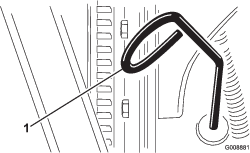
-
Push the dipstick down into the dipstick tube and make sure that it is seated fully. Pull the dipstick out and check the oil level.
-
If the oil level is low, remove the oil fill cap (Figure 26) and gradually add small quantities of oil, checking the level frequently, until the level reaches the Full mark on the dipstick.
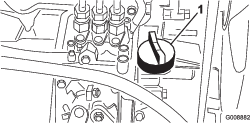
-
Install the oil fill cap and close the hood.
Filling the Fuel Tank
Use only clean, fresh diesel fuel or biodiesel fuels with low (<500 ppm) or ultra low (<15 ppm) sulfur content. The minimum cetane rating should be 40. Purchase fuel in quantities that can be used within 180 days to ensure fuel freshness.
The fuel tank capacity is approximately 42 liters (11 gallons).
Use summer grade diesel fuel (No. 2–D) at temperatures above 20 degrees F (–7 degrees C) and winter grade (No. 1-D or No. 1-D/2-D blend) below that temperature. Use of winter grade fuel at lower temperatures provides lower flash point and cold flow characteristics which will ease starting and reduce fuel filter plugging.
Use of summer grade fuel above 20 degrees F (-7 degrees C) will contribute toward longer fuel pump life and increased power compared to winter grade fuel.
Biodiesel Ready
This machine can also use a biodiesel blended fuel of up to B20 (20% biodiesel, 80% petrodiesel). The petrodiesel portion should be low or ultra low sulfur. Observe the following precautions:
-
The biodiesel portion of the fuel must meet specification ASTM D6751 or EN14214.
-
The blended fuel composition should meet ASTM D975 or EN590.
-
Painted surfaces may be damaged by biodiesel blends.
-
Use B5 (biodiesel content of 5%) or lesser blends in cold weather
-
Monitor seals, hoses, gaskets in contact with fuel as they may be degraded over time.
-
Fuel filter plugging may be expected for a time after converting to biodiesel blends.
-
Contact your distributor if you wish for more information on biodiesel
-
Clean the area around the fuel tank cap (Figure 27).
-
Remove the fuel tank cap.
-
Fill the tank to the bottom of the filler neck. Do not overfill. Install the cap.
-
To prevent a fire hazard, wipe up any fuel that may have spilled.
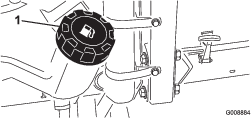
Danger
Under certain conditions, diesel fuel and fuel vapors are highly flammable and explosive. A fire or explosion from fuel can burn you and others and can cause property damage.
-
Use a funnel and fill the fuel tank outdoors, in an open area, when the engine is off and is cold. Wipe up any fuel that spills.
-
Do not fill the fuel tank completely full. Add fuel to the fuel tank until the level is 6 to 13 mm (1/4 to 1/2 inch) below the bottom of the filler neck. This empty space in the tank allows the fuel to expand.
-
Never smoke when handling fuel, and stay away from an open flame or where fuel fumes may be ignited by a spark.
-
Store fuel in a clean, safety-approved container and keep the cap in place.
-
Checking the Cooling System
| Maintenance Service Interval | Maintenance Procedure |
|---|---|
| Before each use or daily |
|
Clean debris off of the radiator and oil cooler daily (Figure 28). Clean the radiator hourly if conditions are extremely dusty and dirty; refer to Cleaning the Engine Cooling System.

The cooling system is filled with a 50/50 solution of water and permanent ethylene glycol anti-freeze. Check the coolant level at the beginning of each day before starting the engine.
The capacity of the cooling system is approximately 5.7 liters (6 quarts).
Caution
If the engine has been running, the pressurized, hot coolant can escape and cause burns.
-
Do not open the radiator cap when the engine is running.
-
Use a rag when opening the radiator cap, and open the cap slowly to allow steam to escape.
-
Check the coolant level in the expansion tank (Figure 29). With a cold engine, the coolant level should be approximately midway between the marks on the side of the tank.
-
If the coolant level is low, remove the expansion tank cap and replenish the system. Do not overfill.
-
Install the expansion tank cap.
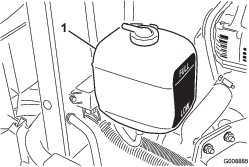
Checking the Hydraulic System
| Maintenance Service Interval | Maintenance Procedure |
|---|---|
| Before each use or daily |
|
The machines reservoir is filled at the factory with approximately 13.2 liters (3.5 U.S. gallons) of high quality hydraulic fluid. Check the level of the hydraulic fluid before the engine is first started and daily thereafter. The recommended replacement fluid is Toro Premium All Season Hydraulic Fluid (Available in 19 liter (5 gallon) pails or 55 gallon drums. See parts catalog or Toro distributor for part numbers.)
Alternate fluids: If the Toro fluid is not available, other fluids may be used provided they meet all the following material properties and industry specifications. Toro does not recommend the use of synthetic fluid. Consult with your lubricant distributor to identify a satisfactory product Note: Toro will not assume responsibility for damage caused by improper substitutions, so use only products from reputable manufacturers who will stand behind their recommendation.
| High Viscosity Index/Low Pour Point Anti-wear Hydraulic Fluid, ISO VG 46 | |||
| Material Properties: | |||
| Viscosity, ASTM D445 | cSt @ 40°C 44 to 48cSt @ 100°C 7.9 to 8.5 | ||
| Viscosity Index ASTM D2270 | 140 to 160 | ||
| Pour Point, ASTM D97 | -34°F to -49°F | ||
| Industry Specifications: | |||
| Vickers I-286-S (Quality Level), Vickers M-2950-S (Quality Level), Denison HF-0 | |||
Important: The ISO VG 46 Multigrade fluid has been found to offer optimal performance in a wide range of temperature conditions. For operation in consistently high ambient temperatures, 65° F (18° C) to 120° F (49° C), ISO VG 68 hydraulic fluid may offer improved performance.
Premium Biodegradable Hydraulic Fluid-Mobil EAL EnviroSyn 46H
Important: Mobil EAL EnviroSyn 46H is the only synthetic biodegradable fluid approved by Toro. This fluid is compatible with the elastomers used in Toro hydraulic systems and is suitable for a wide-range of temperature conditions. This fluid is compatible with conventional mineral oils, but for maximum biodegradability and performance the hydraulic system should be thoroughly flushed of conventional fluid. The oil is available in 19 liters (5 gallon) containers or 55 gallon drums from your Mobil Distributor.
Important: Many hydraulic fluids are almost colorless, making it difficult to spot leaks. A red dye additive for the hydraulic system oil is available in 20 ml (2/3 oz.) bottles. One bottle is sufficient for 15-22 1iters (4-6 U.S. gallons) of hydraulic oil. Order part no. 44-2500 from your authorized Toro distributor.
-
Position the machine on a level surface, lower the cutting units, and stop the engine.
-
Clean the area around the filler neck and cap of the hydraulic tank (Figure 30). Remove the cap.
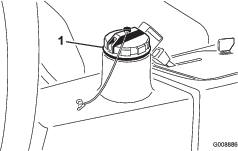
-
Remove the dipstick from the filler neck and wipe it with a clean rag. Insert the dipstick into the filler neck; then remove it and check the fluid level. The fluid level should be within 6 mm (1/4 inch) of the mark on the dipstick.
-
If the level is low, add the appropriate fluid to raise the level to the full mark.
-
Install the dipstick and cap onto the filler neck.
Checking the Tire Pressure
| Maintenance Service Interval | Maintenance Procedure |
|---|---|
| Before each use or daily |
|
The tires are over-inflated for shipping. Therefore, release some of the air to reduce the pressure. The correct air pressure in the tires is 97 to 124 kPa (14 to 18 psi).
Note: Maintain the recommended pressure in all tires to ensure a good quality of cut and proper machine performance.
Danger
Low tire pressure decreases machine side hill stability. This could cause a rollover, which may result in personal injury or death.
Do not under-inflate the tires.
Torquing the Wheel Nuts
| Maintenance Service Interval | Maintenance Procedure |
|---|---|
| After the first hour |
|
| After the first 10 hours |
|
| Every 200 hours |
|
Torque the wheel nuts to 61 to 88 N-m (45 to 65 ft-lb).
Warning
Failure to maintain proper torque of the wheel nuts could result in personal injury.
Starting and Stopping the Engine
You may need to bleed the fuel system if any of the following situations have occurred (refer to Bleeding the Fuel System):
-
Initial start up of a new engine
-
The engine has ceased running due to lack of fuel.
-
Maintenance has been performed upon the fuel system components; i.e. filter replaced, etc.
Starting the Engine
-
Be sure that the parking brake is set and the cutting unit drive switch is in the Disengage position.
-
Remove your foot from the traction pedal and make sure that the pedal is in the neutral position.
-
Move the throttle lever to the 1/2 throttle position.
-
Insert the key into the switch and rotate it to the On/Preheat position until the glow plug indicator light goes out (approximately 7 seconds); then rotate the key to the Start position to engage the starter motor. Release the key when the engine starts. The key will move automatically to the On/Run position.
Important: To prevent overheating of the starter motor, do not engage the starter longer than 15 seconds. After 10 seconds of continuous cranking, wait 60 seconds before engaging the starter motor again.
-
When the engine is started for the first time or after an overhaul of the engine, operate the machine in forward and reverse for one to two minutes. Also operate the lift lever and cutting unit drive switch to be sure of proper operation of all parts.
Turn the steering wheel to the left and right to check steering response; then shut the engine off and check for oil leaks, loose parts, and any other noticeable malfunctions.
Caution
Stop the engine and wait for all moving parts to stop before checking for oil leaks, loose parts, and other malfunctions.
Stopping the Engine
Move the throttle control to the Idle position, move the cutting unit drive switch to Disengage, and rotate the starter key to Off. Remove the key from the switch to prevent accidental starting.
Bleeding the Fuel System
-
Park the machine on a level surface. Make sure that the fuel tank is at least half full.
-
Unlatch and raise the hood.
Danger
Under certain conditions, diesel fuel and fuel vapors are highly flammable and explosive. A fire or explosion from fuel can burn you and others and can cause property damage.
-
Use a funnel and fill the fuel tank outdoors, in an open area, when the engine is off and is cold. Wipe up any fuel that spills.
-
Do not fill the fuel tank completely full. Add fuel to the fuel tank until the level is 6 to 13 mm (1/4 to 1/2 inch) below the bottom of the filler neck. This empty space in the tank allows the fuel to expand.
-
Never smoke when handling fuel, and stay away from an open flame or where fuel fumes may be ignited by a spark.
-
Store fuel in a clean, safety-approved container and keep the cap in place.
-
-
Open the air bleed screw on the fuel injection pump (Figure 31).
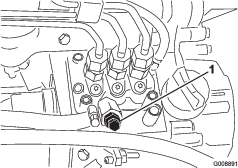
-
Turn the key in the ignition switch to the On position. The electric fuel pump will begin operation, thereby forcing air out around the air bleed screw. Leave the key in the On position until a solid stream of fuel flows out around the screw.
-
Tighten the screw and turn the key to Off.
Note: Normally the engine should start after the above bleeding procedures are followed. However, if the engine does not start, air may be trapped between the injection pump and injectors; refer to Bleeding Air from the Injectors.
Checking the Interlock System
| Maintenance Service Interval | Maintenance Procedure |
|---|---|
| Before each use or daily |
|
Caution
If safety interlock switches are disconnected or damaged the machine could operate unexpectedly causing personal injury.
-
Do not tamper with the interlock switches.
-
Check the operation of the interlock switches daily and replace any damaged switches before operating the machine.
-
Make sure that all bystanders are away from the area of operation. Keep hands and feet away from the cutting units.
-
While sitting on the seat, the engine must not start with either the cutting unit switch engaged or the traction pedal engaged. Correct the problem if it is not operating properly.
-
While sitting on the seat, put the traction pedal in neutral, the parking brake off, and the cutting unit switch in the Off position. The engine should start. Rise from the seat and slowly press the traction pedal, the engine should stop in one to three seconds. Correct problem if it is not operating properly.
Note: The machine is equipped with an interlock switch on the parking brake. The engine will stop if the traction pedal is pressed with the parking brake engaged.
Towing the Traction Unit
In case of an emergency, the machine can be towed for a short distance; however, Toro does not recommend this as a standard procedure.
Important: Do not tow the machine faster than 3 to 4 km/h (2 to 3 MPH) because the drive system may become damaged. If the machine must be moved a considerable distance, transport it on a truck or trailer.
-
Locate the bypass valve on the pump (Figure 32) and rotate it 90°.
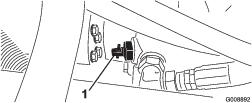
-
Before starting the engine, close the bypass valve by rotating it 90° (1/4 turn). Do not start the engine when the valve is open.
Standard Control Module (SCM)
The Standard Control Module is a potted electronic device produced in a one size fits all configuration. The module uses solid state and mechanical components to monitor and control standard electrical features required for safe product operation.
The module monitors inputs including neutral, parking brake, PTO, start, backlap, and high temperature. The module energizes outputs including PTO, Starter, and ETR (energize to run) solenoid.
The module is divided into inputs and outputs. Inputs and outputs are identified by green LED indicators mounted on the printed circuit board.
The start circuit input is energized by 12 VDC. All other inputs are energized when the circuit is closed to ground. Each input has a LED that is illuminated when the specific circuit is energized. Use the input LED’s for switch and input circuit troubleshooting.
Output circuits are energized by an appropriate set of input conditions. The three outputs include PTO, ETR, and START. Output LED’s monitor relay condition indicating the presence of voltage at one of three specific output terminals.
Output circuits do not determine output device integrity so electrical troubleshooting includes output LED inspection and conventional device and wire harness integrity testing. Measure disconnected component impedance, impedance through wire harness (disconnect at SCM), or by temporarily ”test energizing” the specific component.
The SCM does not connect to an external computer or hand held device, can not be re–programmed, and does not record intermittent fault troubleshooting data.
The decal on the SCM only includes symbols. Three LED output symbols are shown in the output box. All other LED’s are inputs. The chart below identifies the symbols.
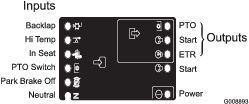
Here are the logical troubleshooting steps for the SCM device.
-
Determine the output fault you are trying to resolve (PTO, START, or ETR).
-
Move key switch to the On position and ensure that the red power LED is illuminated.
-
Move all input switches to ensure all LED’s change state.
-
Position input devices at appropriate position to achieve the appropriate output. Use the following logic chart to determine the appropriate input condition.
-
If specific output LED is illuminated without appropriate output function, check output harness, connections, and component. Repair as required.
-
If specific output LED is not illuminated, check both fuses.
-
If specific output LED is not illuminated and inputs are in appropriate condition, install new SCM and determine if fault disappears.
Each row (across) in the logic chart below identifies input and output requirements for each specific product function. Product functions are listed in the left column. Symbols identify specific circuit condition including: energized to voltage, closed to ground, and open to ground.
| INPUTS | OUTPUTS | ||||||||||
|---|---|---|---|---|---|---|---|---|---|---|---|
| Function | Power ON | In Neutral | Start ON | Brake ON | PTO ON | In Seat | Hi Temp | Backlap | Start | ETR | PTO |
| Start | — | — | + | O | O | — | O | O | + | + | O |
| Run (Off Unit) | — | — | O | O | O | O | O | O | O | + | O |
| Run (On Unit) | — | O | O | — | O | — | O | O | O | + | O |
| Mow | — | O | O | — | — | — | O | O | O | + | + |
| Backlap | — | — | O | O | — | O | O | — | O | + | + |
| Hi Temp | — | O | — | O | O | O | |||||
-
(–) Indicates a circuit closed to ground. – LED ON
-
(O) Indicates a circuit open to ground or de–energized – LED OFF
-
(+) Indicates an energized circuit (clutch coil, solenoid, or start input) LED ON.
-
A Blank indicates a circuit that is not involved with the logic.
To troubleshoot, turn on the key without starting the engine. Identify the specific function that does not work and work across the logic chart. Inspect the condition of each input LED’s to ensure it matches the logic chart.
If the input LED’s are correct, check the output LED. If the output LED is illuminated but the device is not energized, measure available voltage at the output device, continuity of the disconnected device, and potential voltage on the ground circuit (floating ground). Repairs will vary depending on your findings.
Selecting a Blade
Using a Standard Combination Sail
This blade was designed to provide excellent lift and dispersion in almost any condition. If more or less lift and discharge velocity is required, consider a different blade.
Attributes: Excellent lift and dispersion in most conditions.
Using an Angled Sail
The blade generally performs best in lower heights of cut - 1.9 to 6.4 cm (3/4 to 2–1/2 inch).
Attributes:
-
Discharge remains more even at lower heights of cut.
-
Discharge has less tendency to throw left and thus a cleaner look around bunkers and fairways.
-
Lower power requirement at lower heights and dense turf.
Using a High Lift Parallel Sail
The blade generally performs better in the higher heights of cut - 7 to 10 cm (2 to 4 inch).
Attributes:
-
More lift and higher discharge velocity.
-
Sparse or limp turf is picked up significantly at higher heights of cut.
-
Wet or sticky clippings are discharged more efficiently reducing congestion in the deck.
-
Requires more horsepower to run.
-
Tends to discharge further left and can tend to windrow at lower heights of cut.
Warning
Do not use the high lift blade with the mulching baffle. The blade could break, resulting in personal injury or death.
Using an Atomic Blade
This blade was designed to provide excellent leaf mulching.
Attributes: Excellent leaf mulching
Choosing Accessories
Optional Equipment Configurations
| Angle Sail Blade | High Lift Parallel Sail Blade(Do not use with the mulching baffle) | Mulching Baffle | Roller Scraper | |
| Grass Cutting: 1.9 to 4.4 cm (0.75 to 1.75 inch) Height-of-Cut | Recommended in most applications | May work well in light or sparse turf | Has been shown to improve dispersion and after cut performance on northern grasses that are cut at least three times per week and less than 1/3 of the grass blade is removed. Do not use with the high lift parallel sail blade | Can be used any time that rollers build up with grass or large flat grass clumps of grass are seen. The scrapers may actually increase clumping in certain applications. |
| Grass Cutting: 5 to 6.4 cm (2.00 to 2.50 inch) Height-of-Cut | Recommended for thick or lush turf | Recommended for light or sparse turf | ||
| Grass Cutting: 7 to 10 cm (2.75 to 4.00 inch) Height-of-Cut | May work well in lush turf | Recommended in most applications | ||
| Leaf Mulching | Recommended for use with the mulching baffle | Not Allowed | Use with combination sail or angle sail blade only | |
| Pros | Even discharge at lower height of cut Cleaner look around bunkers and fairways Lower power requirements | More lift and higher discharge velocity Sparse or limp turf is picked up at high height of cut Wet or sticky clippings are discharged efficiently | May improve dispersion and appearance in certain grass cutting applications Very good for leaf mulching | Reduces roller buildup in certain applications |
| Cons | Does not lift the grass well in high height of cut applications Wet or sticky grass has a tendency to build up in the chamber, leading to poor quality of cut and higher power requirements | Requires more power to run in some applications Tends to windrow at lower height of cut in lush grass Do not use with the mulching baffle | Grass will build up in the chamber if attempting to remove too much grass with baffle in place |
Operating Tips
Models 30839, 30843 and 30807
Danger
The mower has a unique traction system that will allow the machine to move forward on side hills, even if the uphill wheel should come off of the ground. If this should happen, the operator or any bystanders can be seriously injured or killed in a rollover.
The slope angle at which the machine will tip is dependent on many factors. Among these are: mowing conditions such as wet of undulating turf, speed (especially in turns), position of the cutting units (with Sidewinder), tire pressure, and operator experience.
At side hill angles of 20 degrees or less, the risk of a rollover is low. As the slope angle increases to a recommended maximum limit of 25 degrees, the risk of a rollover increases to a moderate level. Do not exceed a 25 degree side hill slope angle because the risk of a rollover and serious injury or death is very high.
To determine which hills or slopes you may safely operate on, a site survey of the mowing area must be done. When performing this site survey, always use common sense and take into consideration the turf condition and the rollover risk. To determine which hills or slopes may be safely operated on, use the inclinometer provided with each machine. To perform a site survey, lay a 4 ft 2x4 (1.25 meter plank) on the slope surface and measure the angle of the slope. The 2x4 will average the slope but will not take into consideration dips or holes which can cause a sudden change in side hill angle. The maximum side hill angle should not be greater than 25 degrees.
Additionally, the machine is equipped with an angle indicator mounted on the steering tube. This indicates the side hill angle the machine is on and identifies the recommended maximum limit of 25 degrees.
Always wear your seat belt.
-
Practice operating the machine and become thoroughly familiar with it.
-
Start the engine and run it at half idle until it warms up. Push the throttle lever all the way forward, lift the cutting units, disengage the parking brake, press the forward traction pedal, and carefully drive to an open area.
-
Practice moving forward and reverse, and starting and stopping the machine. To stop, take your foot off of the traction pedal and let it return to neutral or press down on the reverse pedal to stop. Going down a hill, you may need to use the reverse pedal to stop.
-
When driving on slopes, drive slowly to maintain steering control and avoid turns to prevent rollovers. In side hill situations you should shift the sidewinder cutting units to the uphill side to give you more stability. Conversely, shifting the cutting units to the down hill side will give you less stability. This should always be done before going on a side hill.
-
When possible, mow up and down hills rather than across them. Have the cutting units lowered when going down a hill to maintain steering control. Do not attempt to turn on a hill.
-
Practice driving around obstacles with the cutting units up and down. Be careful when driving between narrow objects so you do not damage the machine or cutting units.
-
On the Sidewinder unit, get a feel for the reach of the cutting units so you do not hang them up or damage them in any way.
-
Do not shift the units from side to side, unless the cutting units are down and the machine is moving, or the cutting units are up in the transport position. Shifting the cutting units when they are down and the machine is not moving may cause turf damage.
-
Always drive slowly in rough areas.
-
If a person appears in or near the operating area, stop the machine, and do not start it again until the area is cleared. The machine is designed for one person. Never let anyone else ride on the machine with you. This is extremely dangerous and could result in serious injury.
-
Accidents can happen to anyone. The most common causes are excessive speed, sudden turns, terrain (not knowing which slopes and hills can be mowed safely), not stopping the engine before leaving the operator’s seat, and drugs which impair your alertness. Cold capsules or prescription drugs may cause drowsiness, as can alcohol and other drugs. Stay alert and stay safe. Failure to do so could result in serious injury.
-
The Sidewinder offers up to a maximum of 33 cm (13 inches) of overhang, allowing you to trim closer to the edge of sand traps and other obstacles, while at the same time keeping the tractor tires as far away from the edge of traps or water hazards as possible.
-
If an obstacle is in the way, shift the cutting units to easily mow around it.
-
When transporting the machine from one work area to another, raise the cutting units to the fully up position, move the mow/transport slide to the left to transport, and place the throttle in the Fast position.
Changing Mowing Patterns
Change mowing patterns often to minimize aftercut appearance issues induced by repetitive operation in only one direction.
Understanding Counterbalance
The counterbalance system maintains hydraulic back pressure on the deck lift cylinders. This counterbalance pressure transfers cutting deck weight to the mower's drive wheels to improve traction. The counterbalance pressure has been factory set to an optimal balance of aftercut appearance and traction capability in most turf conditions. Decreasing the counterbalance setting can produce a more stable cutting deck, but can decrease the traction capability. Increasing the counterbalance setting can increase the traction capability, but may result in aftercut appearance issues. Reference the service manual for your traction unit for instructions to adjust counterbalance pressure.
Resolving Aftercut Appearance
Reference Aftercut Appearance Troubleshooting Guide available at www.Toro.com
Model 30849
Danger
The slope angle at which the machine will tip is dependent on many factors. Among these are: mowing conditions such as wet of undulating turf, speed (especially in turns), tire pressure, and operator experience.
At side hill angles of 15 degrees or less, the risk of a rollover is low. As the slope angle increases to a recommended maximum limit of 20 degrees, the risk of a rollover increases to a moderate level. Do not exceed a 20 degree side hill slope angle because the risk of a rollover and serious injury or death is very high.
To determine which hills or slopes you may safely operate on, a site survey of the mowing area must be done. When performing this site survey, always use common sense and take into consideration the turf condition and the rollover risk. To determine which hills or slopes may be safely operated on, use the inclinometer provided with each machine. To perform a site survey, lay a 4 ft 2x4 (1.25 meter plank) on the slope surface and measure the angle of the slope. The 2x4 will average the slope but will not take into consideration dips or holes which can cause a sudden change in side hill angle. The maximum side hill angle should not be greater than 20 degrees.
Always wear your seat belt.
-
Practice operating the machine and become thoroughly familiar with it.
-
Start the engine and run it at half idle until it warms up. Push the throttle lever all the way forward, lift the cutting units, disengage the parking brake, press the forward traction pedal, and carefully drive to an open area.
-
Practice moving forward and reverse, and starting and stopping the machine. To stop, take your foot off of the traction pedal and let it return to neutral or press down on the reverse pedal to stop. Going down a hill, you may need to use the reverse pedal to stop.
-
When driving on slopes, drive slowly to maintain steering control and avoid turns to prevent rollovers.
-
When possible, mow up and down hills rather than across them. Have the cutting units lowered when going down a hill to maintain steering control. Do not attempt to turn on a hill.
-
Practice driving around obstacles with the cutting units up and down. Be careful when driving between narrow objects so you do not damage the machine or cutting units.
-
On the Sidewinder unit, get a feel for the reach of the cutting units so you do not hang them up or damage them in any way.
-
Do not shift the units from side to side, unless the cutting units are down and the machine is moving, or the cutting units are up in the transport position. Shifting the cutting units when they are down and the machine is not moving may cause turf damage.
-
Always drive slowly in rough areas.
-
If a person appears in or near the operating area, stop the machine, and do not start it again until the area is cleared. The machine is designed for one person. Never let anyone else ride on the machine with you. This is extremely dangerous and could result in serious injury.
-
Accidents can happen to anyone. The most common causes are excessive speed, sudden turns, terrain (not knowing which slopes and hills can be mowed safely), not stopping the engine before leaving the operator’s seat, and drugs which impair your alertness. Cold capsules or prescription drugs may cause drowsiness, as can alcohol and other drugs. Stay alert and stay safe. Failure to do so could result in serious injury.
-
The Sidewinder offers up to a maximum of 33 cm (13 inches) of overhang, allowing you to trim closer to the edge of sand traps and other obstacles, while at the same time keeping the tractor tires as far away from the edge of traps or water hazards as possible.
-
If an obstacle is in the way, shift the cutting units to easily mow around it.
-
When transporting the machine from one work area to another, raise the cutting units to the fully up position, move the mow/transport slide to the left to transport, and place the throttle in the Fast position.
Using Good Mowing Techniques
-
To begin cutting, engage the cutting units, then approach the mowing area slowly. Once the front cutting units are over the mowing area, lower the cutting units.
-
To achieve the professional straight-line cut and striping that is desirable for some applications, find a tree or other object in the distance and drive straight toward it.
-
As soon as the front cutting units reach the edge of the mowing area, lift the cutting units and perform a tear drop shaped turn to quickly line you up for your next pass.
-
To mow around bunkers, ponds, or other contours easily, use the Sidewinder and move the control lever left or right, depending on your mowing application. The cutting units can also be shifted to vary tire tracking.
-
The cutting units tend to throw grass to the left side of the machine. If trimming around bunkers, it is best to mow in a clockwise direction to prevent throwing clippings into the bunker.
-
The cutting units can be equipped with bolt-in mulching baffles. The mulching baffles perform well when turf is maintained on a regular schedule to avoid removing more than 25 mm (1 inch) of growth per cutting. When too much growth is cut with the mulching baffles installed, after-cut appearance may deteriorate and the observed power to cut the turf increases. The mulching baffles also perform well for shredding leaves in the fall of the year.
Mowing When Grass is Dry
Mow either in the late morning to avoid the dew, which causes grass clumping, or in late afternoon to avoid the damage that can be caused by direct sunlight on the sensitive, freshly mowed grass.
Selecting the Proper Height-of-Cut Setting to Suit Conditions
Remove approximately one inch or no more than 1/3 of the grass blade when cutting. In exceptionally lush and dense grass you may have to raise your height–of–cut setting another notch.
Mowing with Sharp Blades
A sharp blade cuts cleanly and without tearing or shredding the grass blades like a dull blade. Tearing and shredding causes the grass to turn brown at the edges which impairs growth and increases susceptibility to diseases. Make sure blade is in good condition and a full sail is present.
Checking Condition of Cutting Unit
Make sure cutting chambers are in good condition. Straighten any bends in chamber components to assure correct blade tip/chamber clearance.
After Mowing
At the completion of mowing operation, thoroughly wash the machine with a garden hose without a nozzle so that excessive water pressure will not cause contamination and damage to the seals and bearings. Make sure that the radiator and oil cooler are kept free of dirt or grass clippings. After cleaning, it is recommended that the machine be inspected for possible hydraulic fluid leaks, damage or wear to the hydraulic and mechanical components, and the cutting unit blades checked for sharpness.
Important: After washing the machine, move the Sidewinder mechanism from left to right several times to remove water between the bearing blocks and cross tube.
Maintenance
Note: Determine the left and right sides of the machine from the normal operating position.
Recommended Maintenance Schedule(s)
| Maintenance Service Interval | Maintenance Procedure |
|---|---|
| After the first hour |
|
| After the first 10 hours |
|
| After the first 50 hours |
|
| Before each use or daily |
|
| Every 25 hours |
|
| Every 50 hours |
|
| Every 100 hours |
|
| Every 150 hours |
|
| Every 200 hours |
|
| Every 400 hours |
|
| Every 500 hours |
|
| Every 2 years |
|
Caution
If you leave the key in the ignition switch, someone could accidently start the engine and seriously injure you or other bystanders.
Remove the key from the ignition before you do any maintenance.
Service Interval Chart

Pre-Maintenance Procedures
Removing the Hood
The hood may be easily removed to ease maintenance procedures in the engine area of the machine.
-
Unlatch and raise the hood.
-
Remove the hairpin cotter securing the hood pivot to the mounting brackets (Figure 35).

-
Slide the hood to the right side, lift the other side, and pull it out of the brackets.
Note: Reverse the procedure to install the hood.
Using the Cutting Deck Service Latch
When servicing the cutting decks, use the service latch to prevent injury.
-
Center the cutting deck sidewinder with the traction unit.
-
Raise the cutting decks to the transport position.
-
Set the parking brake and turn off the machine.
-
Release the latch rod (Figure 36) from front carrier frame retainer.
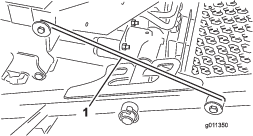
-
Lift the outside of the front cutting decks and place the latch over the frame pin mounted on the front of the operator's platform (Figure 36).
-
Sit on the operator seat and start the traction unit.
-
Lower the cutting decks to the mow position.
-
Turn off the machine and remove the key.
-
Reverse this procedure to unlatch the cutting decks.
Lubrication
Greasing the Bearings and Bushings
| Maintenance Service Interval | Maintenance Procedure |
|---|---|
| Every 50 hours |
|
| Every 500 hours |
|
The machine has grease fittings that must be lubricated regularly with No. 2 General-purpose, lithium base grease. Bearings and bushings must be lubricated daily when operating conditions are extremely dusty and dirty. Dusty and dirty operating conditions could cause dirt to get into the bearings and bushings, resulting in accelerated wear. Lubricate grease fittings immediately after every washing, regardless of interval specified.
The grease fitting locations and quantities are:
-
Rear cutting unit pivot (Figure 37)
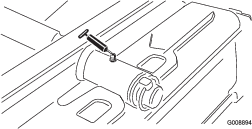
-
Front cutting unit pivot (Figure 38)
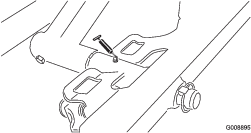
-
SideWinder cylinder ends (2) (Figure 39)
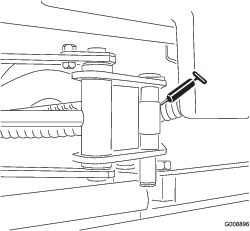
-
Steering pivot (Figure 40)

-
Rear lift arm pivot and lift cylinder (2) (Figure 41)
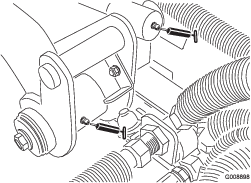
-
Left front lift arm pivot and lift cylinder (2) (Figure 42)
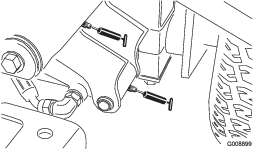
-
Right front lift arm pivot and lift cylinder (2) (Figure 43)
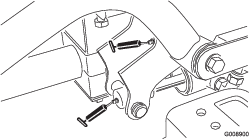
-
Neutral adjust mechanism (Figure 44)
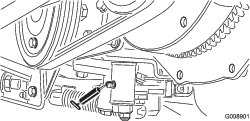
-
Mow/transport slide (Figure 45)

-
Belt tension pivot (Figure 46)
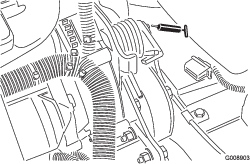
-
Steering cylinder (Figure 47).
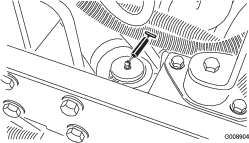
Note: If desired, an additional grease fitting may be installed in the other end of the steering cylinder. Remove the tire, install the fitting, grease the fitting, remove the fitting, and install the plug (Figure 48).

-
Cutting unit spindle shaft bearings (2 per cutting unit) (Figure 49)
Note: Either fitting can be used, which ever is more accessible. Pump grease into the fitting until a small amount appears at bottom of the spindle housing (under the deck).
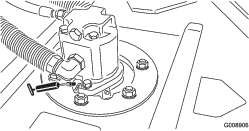
-
Rear roller bearings (2 per cutting unit) (Figure 50)

Note: Make sure the grease groove in each roller mount aligns with the grease hole in each end of the roller shaft. To help align the groove and hole, there is also an alignment mark on one end of the roller shaft.
Important: Do not lubricate the Sidewinder cross tube. The bearing blocks are self-lubricated.
Engine Maintenance
Servicing the Air Cleaner
| Maintenance Service Interval | Maintenance Procedure |
|---|---|
| Every 200 hours |
|
-
Check the air cleaner body for damage which could cause an air leak. Replace if damaged. Check the whole intake system for leaks, damage, or loose hose clamps.
-
Service at the recommended service interval or earlier if engine performance suffers due to extremely dusty, dirty conditions. Changing the air filter before it is necessary only increases the chance of dirt entering the engine when the filter is removed.
-
Be sure the cover is seated correctly and seals with the air cleaner body.
-
Release the latches securing the air cleaner cover to the air cleaner body (Figure 51).

-
Remove the cover from the air cleaner body.
-
Before removing the filter, use low pressure air (40 psi, clean and dry) to help remove large accumulations of debris packed between outside of primary filter and the canister. Avoid using high pressure air which could force dirt through the filter into the intake tract. This cleaning process prevents debris from migrating into the intake when the primary filter is removed.
-
Remove and replace the primary filter (Figure 52).
Cleaning of the used element is not recommended due to the possibility of damage to the filter media.
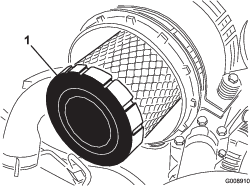
-
Inspect the new filter for shipping damage, checking the sealing end of the filter and the body. Do not use a damaged element.
-
Insert the new filter by applying pressure to the outer rim of the element to seat it in the canister. Do not apply pressure to the flexible center of the filter.
-
Clean the dirt ejection port located in the removable cover. Remove the rubber outlet valve from the cover, clean the cavity and replace the outlet valve.
-
Install the cover orienting the rubber outlet valve in a downward position—between approximately 5:00 to 7:00 when viewed from the end.
-
Secure the cover latches.
Changing the Engine Oil and Filter
| Maintenance Service Interval | Maintenance Procedure |
|---|---|
| After the first 50 hours |
|
| Every 150 hours |
|
-
Remove either drain plug (Figure 53) and let oil flow into a drain pan. When the oil stops flowing, install the drain plug.

-
Remove the oil filter (Figure 54). Apply a light coat of clean oil to the new filter seal before screwing it on. Do not overtighten.
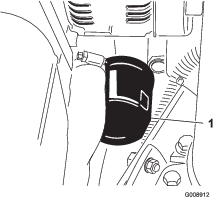
-
Add oil to the crankcase; refer to Checking the Engine Oil Level.
Fuel System Maintenance
Servicing the Fuel Tank
| Maintenance Service Interval | Maintenance Procedure |
|---|---|
| Every 2 years |
|
Drain and clean the tank if the fuel system becomes contaminated or if the machine will be stored for an extended period of time. Use clean fuel to flush out the tank.
Inspecting the Fuel Lines and Connections
| Maintenance Service Interval | Maintenance Procedure |
|---|---|
| Every 400 hours |
|
Inspect the fuel lines and connections for deterioration, damage, or loose connections.
Draining the Water Separator
| Maintenance Service Interval | Maintenance Procedure |
|---|---|
| Before each use or daily |
|
-
Place a clean container under the fuel filter.
-
Loosen the drain valve on the bottom of the filter canister (Figure 55).

-
Tighten the valve after draining.
Changing the Fuel Filter Canister
| Maintenance Service Interval | Maintenance Procedure |
|---|---|
| Every 400 hours |
|
-
Clean the area where the filter canister mounts (Figure 55).
-
Remove the filter canister and clean the mounting surface.
-
Lubricate the gasket on the filter canister with clean oil.
-
Install the filter canister by hand until the gasket contacts the mounting surface; then rotate an additional 1/2 turn.
Bleeding Air from the Injectors
Note: This procedure should be used only if the fuel system has been purged of air through normal priming procedures and the engine will not start; refer to Bleeding the Fuel System.
-
Loosen the pipe connection to the No. 1 nozzle and holder assembly.
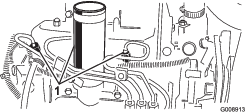
-
Move the throttle to the Fast position.
-
Turn the key in the key switch to the Start position and watch the fuel flow around the connector. Turn the key to the Off position when solid flow is observed.
-
Tighten the pipe connector securely.
-
Repeat the procedure on the remaining nozzles.
Electrical System Maintenance
Servicing the Battery
| Maintenance Service Interval | Maintenance Procedure |
|---|---|
| Every 25 hours |
|
The battery electrolyte level must be properly maintained and the top of the battery kept clean. lf the machine is stored in a location where temperatures are extremely high, the battery will run down more rapidly than if the machine is stored in a location where temperatures are cool.
Maintain the cell level with distilled or demineralized water. Do not fill the cells above the bottom of the split ring inside each cell. Install the filler caps with the vents pointing to the rear (toward the fuel tank).
Danger
Battery electrolyte contains sulfuric acid which is a deadly poison and causes severe burns.
-
Do not drink electrolyte and avoid contact with skin, eyes or clothing. Wear safety glasses to shield your eyes and rubber gloves to protect your hands.
-
Fill the battery where clean water is always available for flushing the skin.
Keep the top of the battery clean by washing it periodically with a brush dipped in ammonia or bicarbonate of soda solution. Flush the top surface with water after cleaning. Do not remove the filler caps while cleaning.
The battery cables must be tight on the terminals to provide good electrical contact.
Warning
Incorrect battery cable routing could damage the tractor and cables causing sparks. Sparks can cause the battery gasses to explode, resulting in personal injury.
-
Always disconnect the negative (black) battery cable before disconnecting the positive (red) cable.
-
Always connect the positive (red) battery cable before connecting the negative (black) cable.
If corrosion occurs at the terminals, disconnect the cables, negative (–) cable first, and scrape the clamps and terminals separately. Reconnect the cables, positive (+) cable first, and coat the terminals with petroleum jelly.
Warning
Battery posts, terminals, and related accessories contain lead and lead compounds, chemicals known to the State of California to cause cancer and reproductive harm. Wash hands after handling.
Servicing the Fuses
The fuses in machines electrical system are located under console cover.
Drive System Maintenance
Adjusting the Traction Drive for Neutral
If the machine moves when the traction pedal is in the NEUTRAL position, adjust the traction cam.
-
Park the machine on a level surface, lower the cutting units, engage the parking brake, shut off the engine, and remove the key from the ignition switch.
-
Chock or block the front and rear wheels on one side.
-
Raise the opposite front and rear wheel off the floor and place support blocks under the frame.
Warning
If the machine is not supported adequately, it may accidentally fall, injuring anyone under the machine.
A front wheel and a rear wheel must be raised off the ground; otherwise, the machine will move during adjustment.
-
Loosen the locknut on the traction adjustment cam (Figure 57).
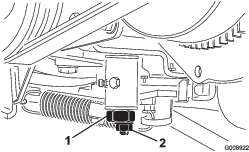
Warning
The engine must be running so that you can make a final adjustment of the traction adjustment cam. Contact with hot or moving parts can result in personal injury.
Keep your hands, feet, face, and other body parts away from the muffler, other hot parts of the engine, and rotating parts.
-
Start the engine and rotate the cam hex in both directions to determine the mid position of the neutral span.
-
Tighten the locknut securing the adjustment.
-
Shut off the engine.
-
Remove the support blocks and lower the machine to the shop floor. Test drive the machine to ensure that it does not move when the traction pedal is in neutral.
Cooling System Maintenance
Cleaning the Engine Cooling System
| Maintenance Service Interval | Maintenance Procedure |
|---|---|
| Before each use or daily |
|
Remove debris from the oil cooler and radiator daily. Clean them more frequently in dirty conditions.
-
Turn the engine off and raise the hood. Clean the engine area thoroughly of all debris.
-
Remove the access panel (Figure 58).

-
Unlatch the oil cooler and pivot it rearward (Figure 59). Clean both sides of the oil cooler and radiator area thoroughly with water or compressed air. Pivot the oil cooler back into position.
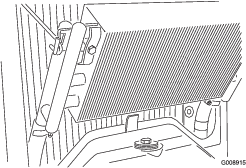
-
Install the access panel and close the hood.
Brake Maintenance
Adjusting the Parking Brake
| Maintenance Service Interval | Maintenance Procedure |
|---|---|
| Every 200 hours |
|
-
Loosen the set screw securing the knob to the parking brake lever (Figure 60).
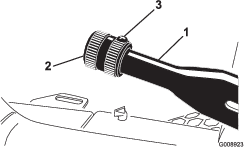
-
Rotate the knob until a force of 41–68 N-m (30–40 lb) is required to actuate the lever.
-
Tighten the set screw after the adjustment has been attained.
Belt Maintenance
Servicing the Engine Belts
| Maintenance Service Interval | Maintenance Procedure |
|---|---|
| After the first 10 hours |
|
| Every 100 hours |
|
Tensioning the Alternator/Fan Belt
-
Open the hood.
-
Check the tension by depressing the belt midway between the alternator and crankshaft pulleys with 30 N-m (22 lb) of force. The belt should deflect 11 mm (7/16 inch).
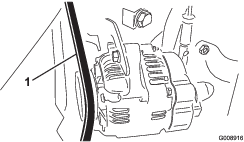
-
If the deflection is incorrect, complete the following procedure to tension the belt:
-
Loosen the bolt securing the brace to the engine and the bolt securing the alternator to the brace.
-
Insert a pry bar between the alternator and engine and pry out on the alternator.
-
When the proper tension is achieved, tighten the alternator and brace bolts to secure the adjustment.
-
Replacing the Hydrostat Drive Belt
-
Insert a nut driver or small piece of tubing onto the end of the belt tensioning spring.
Warning
Use caution when de-tensioning the spring, as it is under a heavy load.
-
Push down and forward on the spring end (Figure 62) to unhook it from the bracket and release tension on the spring.
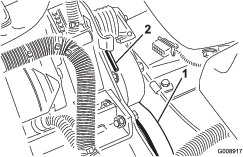
-
Replace the belt.
-
Reverse the procedure to tension the spring.
Controls System Maintenance
Adjusting the Throttle
-
Position the throttle lever rearward so it stops against the control panel slot.
-
Loosen the throttle cable connector on the injection pump lever arm (Figure 63).
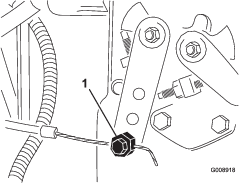
-
Hold the injection pump lever arm against the low idle stop and tighten the cable connector.
-
Loosen the screws securing the throttle control to the control panel.
-
Push the throttle control lever all of the way forward.
-
Slide the stop plate until it contacts the throttle lever and tighten the screws securing the throttle control to the control panel.
-
If the throttle does not stay in position during operation, torque the locknut, used to set the friction device on the throttle lever, to 5–6 N-m (40–55 inch-lb). The maximum force required to operate the throttle lever should be 27 N-m (20 lb).
Hydraulic System Maintenance
Changing the Hydraulic Filter
| Maintenance Service Interval | Maintenance Procedure |
|---|---|
| After the first 10 hours |
|
| Every 200 hours |
|
Use a genuine Toro replacement filter, Part No. 86-3010.
Important: Use of any other filter may void the warranty on some components.
-
Position the machine on a level surface, lower the cutting units, stop the engine, engage the parking brake, and remove the key from the ignition switch.
-
Pinch off the hose to the filter mounting plate.
-
Clean around the filter mounting area. Place a drain pan under the filter (Figure 64) and remove the filter.
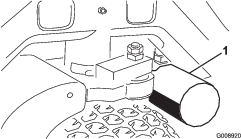
-
Lubricate the new filter gasket and fill the filter with hydraulic fluid.
-
Ensure that the filter mounting area is clean. Screw the filter on until the gasket contacts the mounting plate; then tighten the filter 1/2 turn.
-
Release the hose to the filter mounting plate.
-
Start the engine and let it run for about two minutes to purge air from the system. Stop the engine and check for leaks.
Changing the Hydraulic Fluid
| Maintenance Service Interval | Maintenance Procedure |
|---|---|
| Every 400 hours |
|
If the fluid becomes contaminated, contact your local Toro distributor because the system must be flushed. Contaminated fluid looks milky or black when compared to clean oil.
-
Turn the engine off and raise the hood.
-
Disconnect the hydraulic line (Figure 65) or remove the hydraulic filter (Figure 64) and let the hydraulic fluid flow into a drain pan. Install the hydraulic line when hydraulic fluid stops draining.
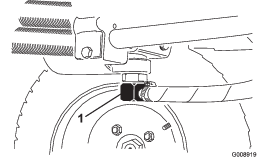
-
Fill the reservoir (Figure 66) with approximately 13.2 liters (3.5 U.S. gallons) of hydraulic fluid; refer to Checking the Hydraulic System.
Important: Use only the hydraulic fluids specified. Other fluids could cause system damage.

-
Install the reservoir cap. Start the engine and use all of the hydraulic controls to distribute the hydraulic fluid throughout the system. Also check for leaks; then stop the engine.
-
Check the fluid level and add enough to raise the level to Full mark on the dipstick. Do not overfill.
Checking the Hydraulic Lines and Hoses
| Maintenance Service Interval | Maintenance Procedure |
|---|---|
| Before each use or daily |
|
Check hydraulic lines and hoses for leaks, kinked lines, loose mounting supports, wear, loose fittings, weather deterioration, and chemical deterioration. Make all necessary repairs before operating.
Warning
Hydraulic fluid escaping under pressure can penetrate skin and cause injury.
-
Make sure all hydraulic fluid hoses and lines are in good condition and all hydraulic connections and fittings are tight before applying pressure to the hydraulic system.
-
Keep your body and hands away from pin hole leaks or nozzles that eject high pressure hydraulic fluid.
-
Use cardboard or paper to find hydraulic leaks.
-
Safely relieve all pressure in the hydraulic system before performing any work on the hydraulic system.
-
Seek immediate medical attention if fluid is injected into skin.
Cutting Deck Maintenance
Separating the Cutting Decks from the Traction Unit
-
Position the machine on a level surface, lower the cutting decks to the floor, shut the engine off, and engage the parking brake.
-
Disconnect and remove the hydraulic motor from the deck (Figure 67). Cover the top of the spindle to prevent contamination.

-
Remove the lynch pin or retaining nut securing the deck carrier frame to the lift arm pivot pin (Figure 68).

-
Roll the cutting deck away from the traction unit.
Mounting the Cutting Decks to the Traction Unit
-
Position machine on a level surface and shut engine off.
-
Move cutting deck into position in front of traction unit.
-
Slide deck carrier frame onto lift arm pivot pin. Secure with lynch pin or retaining nut (Figure 68).
-
Install the hydraulic motor to the deck (Figure 67). Make sure that the O-ring is in position and not damaged.
-
Grease the spindle.
Servicing the Blade Plane
The rotary deck comes from the factory preset at 5 cm (2.00 inch) height-of-cut and blade rake of 7.9 mm ( 0.310 inch). The left-hand and right-hand heights are also preset to within ± 0.7 mm (0.030 inch) of the other.
The cutting deck is designed to withstand blade impacts without deformation of the chamber. If a solid object is struck, inspect the blade for damage and the blade plane for accuracy.
Inspecting the Blade Plane
-
Remove the hydraulic motor from the cutting deck and remove the cutting deck from the tractor.
-
Use a hoist (or minimum of two people) and place the cutting deck on a flat table
-
Mark one end of the blade with a paint pen or marker. Use this end of the blade to check all heights.
-
Position the cutting edge of the marked end of the blade at 12 o’clock (straight ahead in the direction of mowing) (Figure 69) and measure height from table to cutting edge of blade.
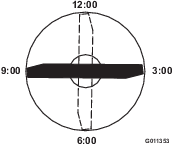
-
Rotate the marked end of the blade to the 3 and 9 o’clock positions (Figure 69) and measure the heights.
-
Compare the 12 o’clock measured height to the height-of-cut setting. It should be within 0.7 mm (0.030 inch). The 3 and 9 o’clock heights should be 3.8±2.2 mm (0.150±.090 inch) higher than the 12 o’clock setting and within 2.2 mm (0.090 inch) of each other.
If any of these measurements are not within specification, proceed to Adjusting the Blade Plane.
Adjusting the Blade Plane
Start with the front adjustment (change one bracket at a time).
-
Remove the height-of-cut bracket, (front, left, or right) from the deck frame (Figure 70).
-
Adjust 1.5 mm (0.060 inch) shims and/or 0.7 mm (0.030 inch) shim between the deck frame and bracket to achieve the desired height setting (Figure 70).
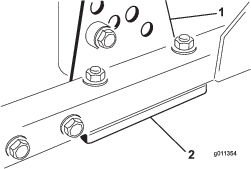
-
Install the height-of-cut bracket to the deck frame with the remaining shims assembled below the height-of-cut bracket.
-
Secure the socket head bolt/spacer and flange nut.
Note: Socket head bolt/spacer are held together with Loctite to prevent the spacer from falling inside the deck frame.
-
Verify the 12 o’clock height and adjust if needed.
-
Determine if only one or both (right-hand and left-hand) height-of-cut brackets need to be adjusted. If the 3 or 9 o’clock side is 3.8±2.2 mm (0.150±0.090 inch) higher than the new front height then no adjustment is needed for that side. Adjust the other side to within ±2.2 mm (0.090 inch) of the correct side.
-
Adjust the right and/or left height-of-cut brackets by repeating steps 1 through 3.
-
Secure the carriage bolts and flange nuts.
-
Again, verify the 12, 3, and 9 o’clock heights.
Servicing the Cutter Blade
Removing the Cutter Blade
The blade must be replaced if a solid object is hit, the blade is out of balance, or if the blade is bent. Always use genuine Toro replacement blades to be sure of safety and optimum performance. Never use replacement blades made by other manufacturers because they could be dangerous.
-
Raise the cutting deck to the highest position, shut the engine off, and engage the parking brake. Block the cutting deck to prevent it from falling accidentally.
-
Grasp the end of the blade using a rag or thickly padded glove. Remove the blade bolt, anti-scalp cup, and blade from the spindle shaft (Figure 71).
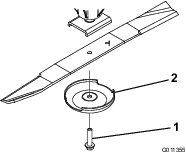
-
Install the blade, sail facing toward the cutting deck, with the anti-scalp cup and blade bolt (Figure 71). Tighten blade bolt to 115–149 N-m (85–110 ft-lb).
Danger
A worn or damaged blade can break, and a piece of the blade could be thrown into the operator’s or bystander’s area, resulting in serious personal injury or death
-
Inspect the blade periodically for wear or damage.
-
Never weld a broken or cracked blade.
-
Always replace a worn or damaged blade.
-
Inspecting and Sharpening the Blade
-
Raise the cutting deck to the highest position, shut the engine off, and engage the parking brake. Block the cutting deck to prevent it from falling accidentally.
-
Examine the cutting ends of the blade carefully, especially where the flat and curved parts of the blade meet (Figure 72). Since sand and abrasive material can wear away the metal that connects the flat and curved parts of the blade, check the blade before using the machine. If wear is noticed (Figure 72), replace the blade; refer to Removing the Cutter Blade.
Danger
If the blade is allowed to wear, a slot will form between the sail and flat part of the blade (Figure 72). Eventually a piece of the blade may break off and be thrown from under the housing, possibly resulting in serious injury to yourself or bystanders.
-
Inspect the blade periodically for wear or damage.
-
Always replace a worn or damaged blade.
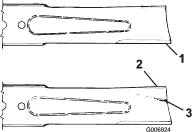
-
-
Inspect the cutting edges of all blades. Sharpen the cutting edges if they are dull or nicked. Sharpen only the top of the cutting edge and maintain the original cutting angle to make sure of sharpness (Figure 73). The blade will remain balanced if the same amount of metal is removed from both cutting edges.

-
To check the blade for being straight and parallel, lay the blade on a level surface and check its ends. The ends of the blade must be slightly lower than the center, and the cutting edge must be lower than the heel of the blade. This blade will produce good quality of cut and require minimal power from the engine. By contrast a blade that is higher at the ends than the center, or if cutting edge is higher than the heel, the blade is bent or warped and must be replaced.
-
Install the blade, sail facing toward cutting deck, with the anti-scalp cup and blade bolt. Tighten the blade bolt to 115–149 N-m (85–110 ft-lb).
Checking the Blade Stopping Time
| Maintenance Service Interval | Maintenance Procedure |
|---|---|
| Before each use or daily |
|
The blades of the cutting deck should come to a complete stop in approximately 5 seconds after you shut down the cutting deck engagement switch.
Note: Make sure the decks are lowered onto a clean section of turf or hard surface to avoid thrown dust and debris.
To verify this stopping time, have a second person stand back from the deck at least 6 m (20 feet) and watch the blades on one of the cutting decks. Have the operator shut the cutting decks down and record the time it takes for the blades to come to a complete stop. If this time is greater than 7 seconds, the braking valve needs adjustment. Call your Toro Distributor for assistance in making this adjustment.
Servicing the Front Roller
Inspect the front roller for wear, excess wobble, or binding. Service or replace the roller or components if any of these conditions exist.
Disassembling the Front Roller
-
Remove the roller mounting bolt (Figure 74).
-
Insert a punch through the end of the roller housing and drive the opposite bearing out by alternating taps to the opposite side of inner bearing race. There should be a 1.5 mm (0.060 inch) lip of inner race exposed.
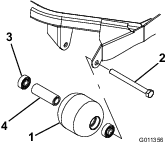
-
Push the second bearing out in press.
-
Inspect the roller housing, bearings, and bearing spacer for damage (Figure 74). Replace damaged components and assemble.
Assembling the Front Roller
-
Press the first bearing into the roller housing (Figure 74). Press on the outer race only or equally on the inner and outer race.
-
Insert the spacer (Figure 74).
-
Press the second bearing into the roller housing (Figure 74) pressing equally on the inner and outer race until the inner race comes in contact with the spacer.
-
Install the roller assembly into the deck frame.
Important: Securing the roller assembly with a gap larger than 1.5 mm (0.060 inch) creates a side load on the bearing and can lead to premature bearing failure
-
Verify that there is no more than a 1.5 mm (0.060 inch) gap between roller assembly and the roller mount brackets of the deck frame. If there is a gap over 1.5 mm (0.060 inch), install enough 5/8 inch diameter washers to take up the slop.
-
Secure the mounting bolt to 108 N-m (80 ft-lb).
Storage
Storing the Battery
If the machine will be stored more than 30 days, remove the battery and charge it fully. Store the battery in a cool atmosphere to avoid quick deterioration of the charge in the battery. To prevent the battery from freezing, make sure it is fully charged. The specific gravity of a fully charged battery is 1.265–1.299.
Preparation for Seasonal Storage
Follow these procedures anytime you will be storing the machine for more than 30 days.
Preparing the Traction Unit
-
Thoroughly clean the traction unit, cutting units, and engine.
-
Check the tire pressure. Inflate all tires to 97 to 110 kPa (14 to 18 psi).
-
Check all fasteners for looseness; tighten as necessary.
-
Grease or oil all grease fittings and pivot points. Wipe up any excess lubricant.
-
Lightly sand and use touch-up paint on painted areas that are scratched, chipped, or rusted. Repair any dents in the metal body.
-
Service the battery and cables as follows:
-
Remove the battery terminals from the battery posts.
-
Remove the battery.
-
Slowly recharge the battery before storage and every 60 days thereafter for 24 hours to prevent lead sulfation of the battery.
To prevent the battery from freezing, make sure it is fully charged. The specific gravity of a fully charged battery is 1.265–1.299.
-
Clean the battery, terminals, and posts with a wire brush and baking soda solution.
-
Coat the cable terminals and battery posts with Grafo 112X skin-over grease (Toro Part No. 505-47) or petroleum jelly to prevent corrosion.
-
Either store it on the shelf or on the machine in a cool area. Leave the cables disconnected if it is stored on the machine.
-
Preparing the Engine
-
Drain the engine oil from the oil pan and replace the drain plug.
-
Remove and discard the oil filter. Install a new oil filter.
-
Refill the oil pan with approximately 3.8 liters (4 quarts) of SAE 15W-40 motor oil.
-
Start the engine and run it at idle speed for approximately two minutes.
-
Stop the engine.
-
Thoroughly drain all fuel from the fuel tank, fuel lines, fuel filter, and water separator assembly.
-
Flush the fuel tank with fresh, clean diesel fuel.
-
Secure all fuel system fittings.
-
Thoroughly clean and service the air cleaner assembly.
-
Seal the air cleaner inlet and the exhaust outlet with weatherproof tape.
-
Check anti-freeze protection and add as needed for expected minimum temperature in your area.
Preparing the Cutting Deck
If the cutting deck is separated from the traction unit for any length of time, install a spindle plug in the top of the spindle to protect the spindle from dust and water.

